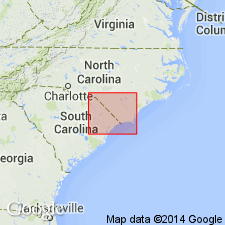
- Usage in publication:
-
- Donoho Creek Formation*
- Modifications:
-
- First used
- AAPG geologic province:
-
- Atlantic Coast basin
Summary:
The name Donoho Creek Formation of the Black Creek Group is used. Formal proposal will follow in Sohl and Owens (1991).
Source: GNU records (USGS DDS-6; Reston GNULEX).
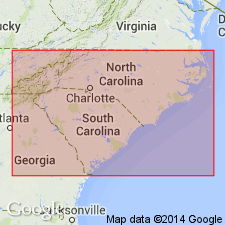
- Usage in publication:
-
- Donoho Creek Formation*
- Modifications:
-
- Named
- Dominant lithology:
-
- Sand
- Clay
- AAPG geologic province:
-
- Atlantic Coast basin
Summary:
The Donoho Creek Formation is here named the upper formation of the Black Creek Group (revised) in the Cape Fear Arch, bounded by the Tar River, NC, and the Pee Dee River, SC. It is a prodelta-delta front-shallow shelf deposit and consists of dark-gray, massively bedded, bioturbated, micaceous, sparingly glauconitic, clayey sand. Disconformably overlies the Bladen Formation (revised) or the Tar Heel Formation (new name) of the Black Creek; disconformably underlies reworked shelly sand of the basal Peedee Formation and younger Tertiary deposits. Thickness up to 180 ft. Age is early Maastrichtian, based on foraminifers and nannofossils.
Source: GNU records (USGS DDS-6; Reston GNULEX).
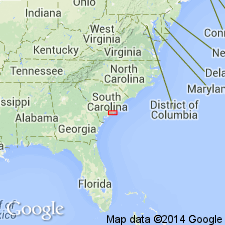
- Usage in publication:
-
- Donoho Creek Formation*
- Modifications:
-
- Principal reference
- Revised
- Age modified
- Biostratigraphic dating
- AAPG geologic province:
-
- Atlantic Coast basin
Summary:
Pg. 11 (fig. 8), 26-27, 31 (fig. 22), 36. Donoho Creek Formation of Black Creek Group. Occurs in subsurface between 873 and 1,072 feet in Clubhouse Crossroads No. 1 drill core, near Clubhouse Crossroads, Dorchester County, southeastern South Carolina [GNU records (USGS DDS-6; Reston GNULEX, Aug. 22, 1990) state this is principal reference section]. Sediments previously included in the Peedee Formation by Hazel and others (1977) and Gohn and others (1977). Consists mostly of calcareous silty clays and clayey silts and fine sands. Thickness 199 feet. Is top formation of Black Creek Group. Overlies Bladen Formation; underlies Peedee Formation. Age is Late Cretaceous (early Maastrichtian; early Navarroan Provincial Age; GLOBOTRUNCANA FALSOSTUARTI planktic foram zone, QUADRUM TRIFIDUM (NC20) calcareous nannofossil zone, ESCHARACYTHERIDEA PINOCHII ostracode zone).
Source: Publication; GNU records (USGS DDS-6; Reston GNULEX).
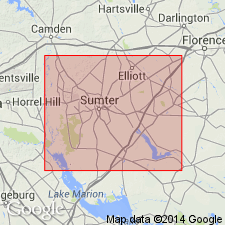
- Usage in publication:
-
- Donoho Creek Formation*
- Modifications:
-
- Areal extent
- Age modified
- AAPG geologic province:
-
- Atlantic Coast basin
Summary:
Black Creek Group strata in corehole in Sumter Co., central SC, are similar to subdivisions of Black Creek strata described by Sohl and Owens (1991) for NC and eastern SC. In the study area, the subdivisions of Black Creek Group are queried as Tar Heel(?) Formation, Bladen(?) Formation, and Donoho Creek(?) Formation [until more detailed information is known]. Figure 4 shows correlation with Ripley Formation and its Cusseta Sand Member, and assignment to Navarroan provincial stage.
Source: GNU records (USGS DDS-6; Reston GNULEX).
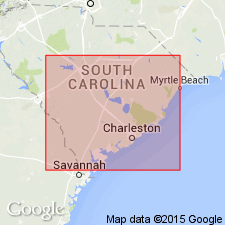
- Usage in publication:
-
- Donoho Creek Formation*
- Modifications:
-
- Age modified
- Biostratigraphic dating
- AAPG geologic province:
-
- Atlantic Coast basin
Summary:
Donoho Creek Formation. Age is Late Cretaceous (late Campanian). Fossils indicate the Donoho Creek occurs within: (1) OSCULAPOLLIS AEQUALIS palynological zone, proposed herein; (2) CC22 to CC23 calcareous nannofossil zone of Sissingh (1977, 1978); (3) EXOGYRA PONDEROSA to E. COSTATA Coastal Plain mollusk zone of Stephenson (1923); and (4) BOSTRYCHOCERAS POLYPLOCUM to NOSTOCERAS HYATTI European Tethyan ammonoid zone of Gradstein and others (1995, 2004).
Source: Publication.
For more information, please contact Nancy Stamm, Geologic Names Committee Secretary.
Asterisk (*) indicates published by U.S. Geological Survey authors.
"No current usage" (†) implies that a name has been abandoned or has fallen into disuse. Former usage and, if known, replacement name given in parentheses ( ).
Slash (/) indicates name conflicts with nomenclatural guidelines (CSN, 1933; ACSN, 1961, 1970; NACSN, 1983, 2005, 2021). May be explained within brackets ([ ]).

